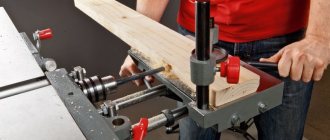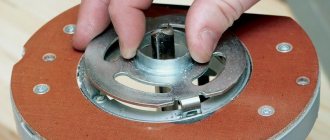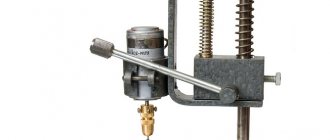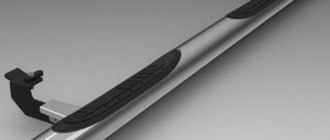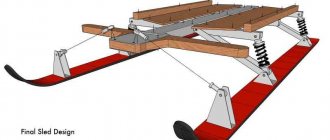Do-it-yourself belt sander from a drill + photo and video
Most amateur craftsmen for small amounts of grinding (which is required from time to time) use grinding machines that they make with their own hands.
As an abrasive tool, such devices usually use discs and belts made of fabric, as well as sanding paper. This can be explained by the fact that they are inexpensive and can be easily changed if you need to sand at a different grit level.
In addition to grinding metals, wood and plastic, such homemade products can quite successfully sharpen plumbing/carpentry tools, as well as improve drills and turning cutters.
How to make a belt sander
Many home craftsmen and professionals are wondering how to make a grinding machine with their own hands.
The reason for this question is quite simple: the high cost of serial grinding equipment, which not everyone can pay off if not used regularly. In order to make such equipment, you will need several main components: an electric motor, rollers and a reliable frame. Naturally, drawings of such a device or a photo of it would not be superfluous. Also at the end of the article you can watch videos on assembling a tape machine on your own. The motor for belt grinding equipment is not difficult to find; it can be removed from an old washing machine. You will have to make the frame yourself; for this you can use a sheet of metal with dimensions 500x180x20 mm. One side of the frame should be cut very evenly, since it will be necessary to attach the platform on which the electric motor will be mounted to it. The platform for the electric motor should also be made of a sheet of metal with dimensions 180x160x10 mm. Such a platform must be secured to the frame very securely using several bolts.
Another version of the bed
The efficiency of a belt sanding machine directly depends on the characteristics of the electric motor that is installed on it. If you are planning to make a grinding machine with your own hands, then an electric motor with a power of 2.5–3 kW, developing about 1500 rpm, is quite suitable for you. In order for the sanding belt to move at a speed of 20 m/s when using such a motor, the drums must have a diameter of about 200 mm. What’s convenient is that if you choose an engine with these characteristics, you won’t need to make a gearbox for your grinding machine.
The drive shaft is connected directly to the electric motor shaft, and the second - driven - must rotate freely on an axis, which is installed in bearing units. In order for the abrasive belt to touch the surface of the workpiece more smoothly, the section of the frame on which the driven shaft is installed should be made with a slight bevel.
You can make shafts for a belt sanding machine from a chipboard with minimal financial costs. Simply cut square blanks of 200x200 mm in size from such a plate, drill central holes in them and place them on the axle with a package with a total thickness of 240 mm. After this, all you have to do is grind the resulting package and make it into a round shaft with a diameter of about 200 mm.
Drawings and detailed analysis of some parts of a machine made of wood.
Wood belt sander (click to enlarge)
In order for the tape to be located strictly in the middle of the shaft, the diameter of its central part should be 2–3 mm larger than at the edges. And to prevent the tape from slipping on the drum, it is necessary to wrap a layer of thin rubber on it, for which you can use an old tire from a bicycle wheel, having previously cut it along its entire length.
The sanding belt for such a machine, the optimal width of which should be 200 mm, is made from ordinary emery cloth. The standard cloth is cut into strips of the required width, and an abrasive tape is already glued from them. It should be borne in mind that the material is glued end-to-end; for this purpose, dense material is placed on the reverse side, which will strengthen the resulting seam. The properties of such a seam are greatly influenced by the glue; it must be of very high quality, then the material will not tear along the seam after a short period of use.
Several more options for manufacturing belt grinding machines can be seen in the video below.
https://youtube.com/watch?v=opM1afRob6o
Other functional parts
Their list is as follows:
- Base plate. Absorbs elasticity waves.
- Drive board for vibration damping.
- Comb stops (combs). Needed to neutralize vertical vibrations of the workpiece.
- Static side stop. Guarantees the correct feeding of the part and the depth of its horizontal processing.
- Dust catcher.
Drive unit
It is better to make the opening for placing the drive round, so the machine will have less vibration during operation. The motor must not come into contact with the plate.
Installation of the drive in this plate is as follows:
It is better to create the drive board from PCB or fiberglass with a density of at least 1.5 cm.
Thick plywood (1.9 cm) treated with a vibration-absorbing agent is used for the slab.
The board and the plate are separated by a gap of 0.5 - 1 mm. It is desirable for the engine to have mounting feet, and they should extend beyond the body. This will allow the cutter to move upward. To install it, long motor bolts are used. The removal of the cutter is ensured as follows: steel washers with rubber gaskets are put on the bolts in turn between the engine housing and the suspension cushion.
Emphasis
Suitable material for the stop is thick plywood (from 2 cm). It is required to drill 3-5 holes for combs and risers. The first two are located 5 mm from the extreme sides of the cutout for the cutter. Others - after 2.5-3 cm. The positions of the stops depend on the parameters and quality of the workpiece.
The side support diagram is as follows:
It can have this configuration:
System elements
- A 15-20 liter bucket with a tight lid and snap-on latches.
- Pipe 1 – inlet. The diameter is 2 cm. Its end is beveled by 45 degrees and rotated by 25 degrees to the outside. It is placed 2 cm from the side of the container.
- Branch pipe-2 – exhaust. Diameter – 3 cm. Placed strictly vertically in the bucket. Its selective ending is narrowed to 1.5-2 cm.
- Vacuum cleaner.
Combs
Oak or walnut is used for combs, without fungi or defects. They are made on the right and left sides for ease of feeding the workpiece.
Drawing:
The length of the first tooth is reduced by 3 mm. The reason is that it acts as a rebound spring for the entire ridge. Without this, damage may occur.
The ridges are attached to the stop using a special bolt through a slotted hole.
The non-working element is fixed with a self-tapping screw to the same stop through hole D7.
To work, the comb is positioned so that it contacts the workpiece with all teeth except the initial one. Then it is secured with a lamb.
Making a grinder from a computer hard drive + (Video)
Any old hard drive can be converted into a miniature grinding machine. To do this you need to follow these steps:
- completely disassemble the hard drive and remove from the case everything that is located to the left of the magnetic disks;
- cut out a working circle from sandpaper, make a hole in the center of the circle for the spindle;
- stick several strips of double-sided tape onto the rotating disk of the hard drive and secure it with sandpaper;
- make a protective screen to protect the eyes from the possible ejection of the manufactured sanding disc;
- connect the finished design to the power supply from the computer and use it.
Of course, this design does not have high power, but it is quite possible to sharpen a small knife or scissors.
Making a belt sander with your own hands + (Video)
Making a belt sander yourself is not at all difficult; you need to complete the following steps:
- select suitable materials and parts;
- create a reliable basis for securing the tool;
- install a suitable tabletop;
- secure the vertical posts with tensioner and drum;
- mount the motor and drums;
- secure with sanding tape.
To process fairly large parts and elements, it is necessary to make a large copy of a serial grinder. For example, if you take an electric motor with a power of 2 kW or more powerful with a rotor speed of 1500 rpm, then you don’t need to install a gearbox. The power of such an engine is quite enough to rotate a drum about 20 cm in diameter and process parts of about 2 m.
You can also use an electric motor from an old washing machine. In this case, the frame is made from a thick sheet of iron, preparing a place for installing the motor and carefully securing it with bolts to eliminate vibration. The design of such a machine consists of 2 drums, one of which is fixed, and the second can be tensioned and rotates on bearings around an axis. It is advisable to make the base for the machine from metal or several sheets of thick plywood. The drums are made on a lathe from chipboard. The tape is cut from sandpaper sheets about 20 cm wide and secured to the frame. The larger the table size, the larger the parts can be stacked and processed in the future. Drawings of finished products can be found online.
Garden shredder
Using an electric screwdriver, you can make a shredder of garden branches (with a diameter of no more than 1 cm) or grass. The power of the screwdriver should not exceed 0.5 kW.
When working, it is recommended to follow the following sequence of operations:
- Prepare a container that will contain the grass or branches to be chopped. This could be a boiler or a large bucket.
- In the central part of the bottom of the container, drill a hole into which the shaft will be inserted to fix the cutting elements of the chopper.
- To install the container and convenient work, you can install it on the edge of the table or make a frame for this from wooden slats.
- Install the cutting elements on the shaft, securing them with bolts. For this purpose, hacksaw blades installed with the sharpening point downwards are better suited.
- Install a screwdriver with installed knives at the bottom of the frame.
- Solder the button to turn on the unit.
- Cut a hole (10x20 cm) in the lower part of the container wall. Insert a metal or plastic sleeve into it, through which the crushed raw materials will be discharged.
The device is ready for use. To ensure efficient operation, it is recommended to first break the branches into small pieces.
Photo of a do-it-yourself drilling machine
Making a grinder from a grinder
Many may say that the “grinder” is the same as an angle grinder, but there are some subtleties hidden here. It should be borne in mind that the angle grinder has very high speeds and often quite a decent weight. To polish a surface with a grinder, you need to have considerable experience in this matter and use special polishing discs and circles. The grinder has much lower engine speed and weight. To operate a factory grinding machine, no specific experience or skill is required. You can independently make a good grinder from an angle grinder, which is not inferior in its parameters to a factory machine, only by modifying its electrical circuit, by installing the regulator at lower speeds and by using special grinding attachments.
Converting a chainsaw into an angle grinder
Sometimes it becomes necessary to cut off a pipe or corrugated sheet in a place where there is no electricity. For this, a chainsaw grinder is used, which can be easily converted using a purchased attachment.
- drive pulley or drum;
- protective casing;
- belt drive and a set of keys and studs.
To install this device on a chainsaw you need:
- remove the bar and chain;
- empty the oil tank and remove the clutch drum;
- mount the device pulley on the drive shaft of the drive sprocket;
- secure the protective device and install the belt drive;
- install the cutting disc - and the mechanism is ready to work.
The main advantage of the design is that it can be used in places where there is no electricity. When working with such a machine, extreme caution must be taken, since the chainsaw has a higher torque than a standard angle grinder. In this case, the risk of cutting blade destruction increases.
Manufacturing algorithm
Considering that home machines will be interchangeable in terms of the type of processing, and the decisive role will be played by the attachment installed in the drill, we will consider two main options for home-made units - horizontal and vertical.
The procedure for assembling a vertical machine is as follows.
- Cut a square base 50 by 50 cm from a piece of metal or wood, with a thickness of 10 to 20 mm.
- Drill a hole in it exactly in the center at a distance of 1-2 cm from the edge for mounting the stand. The diameter of the stand must be at least 5 cm.
- Install the stand, center it using a level and weld it with a welding electrode. If you are making a wooden machine and the stand will be wooden, then firmly fix it with self-tapping screws.
- Using metal clamps, secure the drill to a movable element that will be put on the stand, forming a lowering/raising spindle.
Place the spring on the strut. Its length must be at least 2/3 of the rack. Having placed the drill on the stand, mark the place where the drill will hit when lowering the spindle. According to this place, cut two through hollows in the frame crosswise. A table is installed in the groove on the threaded pin on which the workpiece will be mounted. A nut is screwed onto the pin from the bottom side; it will fix the table in the desired position.
You can also attach the table to the pin from the outside with a nut, recessing it into the surface of the table so that it does not interfere with the placement of workpieces. It is important that after securing with a nut, the length of the outer part of the pin is flush with the top surface of the table.
The assembly algorithm for a horizontal machine looks like this.
- Cut a rectangular frame - dimensions are determined individually.
- At one edge, secure a seat for a drill with a hollow in the upper part corresponding to the size of the tool.
- Secure the drill to it with a clamp.
- Cut a through groove for the pin along the frame, and install two metal corners along the edges along which the pressure sleeve will move.
- The width of the pressure sleeve must exactly match the distance between the guide angles (runners). A threaded pin is screwed into it from below, which will move in the hollow.
- By moving the sleeve close to the drill chuck, determine the place where the special headstock will be installed for fixing the workpieces.
- Attach the headstock to the bushing with a metal cone-shaped pin placed in the center.
- The sleeve is fixed in the desired position (for clamping the workpiece) with a nut screwed onto the pin from below.
In both options, it is necessary to provide special adjustable legs for the frame.
If the bed rests flat on a workbench or table, it will become impossible to adjust and fix the clamping sleeve on a horizontal machine or the workpiece table on a vertical one.
Required materials and tools
The torque-creating element, and accordingly the main working part in each type of machine, is the drill. The type of processing will largely depend on the attachment installed in its cartridge. Therefore, identical materials will be needed to assemble them.
To assemble a lathe, grinding machine:
- rectangular metal or wooden base, bed;
- clamping sleeve;
- a clamping head, which will be attached to the drill chuck;
- runners for the pressure sleeve;
- seat for fixing the drill.
Materials for assembling a drilling and milling machine:
- square bed;
- a metal stand on which the spindle with the drill attached will move;
- a spring corresponding to the diameter of the rack;
- table for workpieces;
- pin for fastening the table.
Tools you will need:
- screwdriver;
- pliers;
- hacksaw for wood or metal;
- fastening elements - bolts, screws, nuts;
- welding machine.
If you plan to make a metal machine, then a necessary condition will be the presence of a welding machine. Since the machine is intended more for home use, its drawings and dimensions of its component elements are set individually.
Types of do-it-yourself drilling machines
There are different types of drill presses made at home. They differ in: material of manufacture, structure, size.
And home craftsmen never stop coming up with new designs and selecting sizes for drilling machines. After all, not everyone makes machines according to ready-made drawings.
Here are some of the most popular drill press designs:
Wireless machine made of wood. This design is well suited for portable drilling of large items. Since the operation of the drill in such a machine is provided by the battery, it is necessary to make a special wooden box. The machine drawing is adjusted independently to the dimensions of the built-in drill.
Mini drilling machine. Making such a tool will not take much effort and time. This design is considered the most economical and does not require a large amount of materials. The model is designed depending on the size and shape of the drill; the drill itself can be secured with ordinary rubber bands or cable ties.
Machine made of plastic pipes. This option is good for those who have pipe scraps left after plumbing repairs. In another case, this option is very economical, since PVC pipes are cheaper than metal or wood. It’s not that difficult to make, the main thing is to maintain the proportions and dimensions.
Cool ideas and lifehacks for using a screwdriver at home
In addition to the listed mechanisms, a screwdriver can also be used to implement other ideas on the farm. This hand-held power tool will help you automate the opening of an entrance gate, make a winch for a car, or make scissors for cutting metal. If you attach an attachment for cutting tin to it, you can turn an ordinary rubber boat into a motor boat, and modernize the process of drilling holes for ice fishing. In addition, everyone knows that a screwdriver is used as a drive for a mixer, meat grinder or juicer.
After reading the article, the reader gained knowledge about the unconventional use of a screwdriver. Now he can use this hand tool to create carpentry equipment, improve children's vehicles and other useful things in the home.
Original idea
This design is very versatile, since its basic part (base and spindle box) is the working part of several other devices described in the following articles:
- DIY wood lathe. Description, drawing, video.
- Do-it-yourself thicknesser machine: drawings, photos and videos.
- Homemade grinding machine from a drill (screwdriver). Description, drawings, video.
These articles contain photos and videos of do-it-yourself machines.
| Turning | Thicknesser | Grinding |
Thus, part of the structure of the described machine can be used for the manufacture and subsequent assembly of three more additional devices. If necessary, having all the components, you can assemble the devices you need at the moment at your own discretion.
Make or buy?
An electric drill is a ready-made drive, gear, spindle and chuck in a monoblock. Place it on the carriage of the machine and you can drill. In terms of accuracy, the solution, generally speaking, is not optimal (see below), but in many cases it is acceptable, but eliminates the need to order expensive turned parts of increased accuracy, see below. In view of this, frames for installing drills are now sold only on the street from trays; prices are affordable. When choosing one to make a drilling machine from a drill, be guided primarily by the operating mode of the equipment; The price also depends on it:
- Occasional drilling/milling for yourself with the accuracy of what you get - cast plastic bed or stamped steel. The feed mechanism is lever with a cranked lever (see below). Carriage sliding bearings (see below) are steel on steel or with nylon liners. Prices are $20-$30.
- Regular drilling for yourself or to order with ordinary machine-building precision. The materials processed are up to the hardness and toughness of ordinary structural steel. Everything is the same, but the sliding bearings are steel on steel (worse) or with bronze bushings, and the frame is cast iron or (more expensive) composite, also vibration-absorbing. Prices: $30-$40.
- Regular drilling and milling of any materials that can be tooled with periodic overloads of the tool and/or with increased accuracy - plain bearings are only bronze on steel, cast iron frame. The feed mechanism is rack and pinion (see below); vibration-absorbing console. Prices: $60-$180.
Choosing a bed
The stand for the drill (which sellers for some reason stubbornly call stands) must be chosen not according to - not “China”); Now the market is full of “German China”, not to mention products from post-Soviet states. The design needs to be checked.
First, samples with plastic non-nylon liners for sliding bearings are definitely rejected: runout and drill drift of more than 0.5 mm will appear already on the 10th – 20th “hole” and will further increase. The second is console play. We take it by the far end, swing it up and down and to the sides while holding the latch. There should be no noticeable “chatter” (the tactile sense of an untrained person feels a beat of 0.4-0.5 mm).
Next is an inspection of the structure, see Fig. below. For regular drilling, the one shown in pos. 1. The ideal option is at pos. 2: collet clamp of the drill, shifting the column to the side reduces the vibration of the console by an order of magnitude, and by turning it sideways by 45 degrees, you can mill the part by hand with the precision “as best you can” on a standard fixed table, removing a couple of table fasteners, because in this case, its manual displacement relative to the horizontal working axis of the console will be linear.
How to choose a bed (stand) for a drill
And here is a sample for pos. 3 do not take under any circumstances. Firstly, the collar of its column is low and its fastening is unreliable. Secondly, longitudinal grooves under the table facilitate manual milling “as it happens,” but, unlike diagonal ones, they do not dampen vibrations of the bed. Moreover, they will concentrate where shown by the arrows (the tide under the column is made too narrow) and from there they will go straight into the column and table.
Which is cheaper?
Bench Drill Press Spindle Drawings
Let’s say the price for the machine you like doesn’t suit you. Or a drill, if it’s a “crowbar” one, with an impact mechanism, that was used in work on building structures and the beating of the chuck is visible to the eye. Then the first thing we do is find out if there is a craftsman within reach who owns a lathe with high precision (no rougher than 0.02 mm). Which, by the way, is not a fact - a high-precision machine is very expensive and never pays off with the flow of regular orders. But let's say he was found. We take the drawing in Fig. on the right, we go to him and ask if he can turn it out of steel no worse than 30KhGSA, and how much he will charge for the work. “This” is the drawings of the tabletop drill spindle. The rest of its parts can be turned on a regular machine, or found in ruins at an iron market or in your trash. Most likely, it will turn out that it is cheaper to buy a bed + table, and if you estimate the costs for the rest, then perhaps a drill of increased accuracy will emerge. There are some of these on sale; they can be recognized by the absence of a striking mechanism and a collar specifically for installation in the frame: a turned steel cuff is put on it.
Characteristics that a belt for a sanding unit must meet
Selecting an abrasive strip is an important step when assembling a mini-grinder with your own hands. First of all, you need to decide on the length of the tape and its width. The geometric parameters of the strip are influenced by two main factors:
- grinder dimensions;
- purpose of the unit.
Fabric base withstands surface tension better
Endless abrasive strips are also classified into grit types. The length of the sanding strips can be different (from 610 to 1830 mm). Such tapes have a width of 50 or 100 mm. The first option is most often found in units assembled by hand at home.
A high-quality abrasive strip must have an elastic fabric base
When choosing the right tool, you also need to pay attention to how many revolutions the strip can withstand. It is recommended to purchase products that can operate at 1500 rpm
This option is best suited for making a belt grinder with your own hands. The drawing drawn up earlier must contain information about the dimensions of the abrasive strip and its other characteristics.
A good tape must have high abrasive resistance. The wear resistance of the tape depends on this indicator. For homemade machines, it is recommended to use belts whose length is no more than 123 cm. The abrasive strip must not only be resistant to wear, but also have good resistance to high temperatures generated during friction against the workpiece during operation.
It is worth noting that short-length tapes are much more susceptible to wear than longer products.
Experts advise paying attention to pictures depicting finished products. Photos of the machines allow us to answer the question of how to make a grinder with your own hands
The design of the device can be significantly simplified if ready-made elements purchased separately are used in its assembly.
The speed and quality of product processing depends on the choice of tape.
And finally, special attention must be paid to the place where the abrasive tape is glued. The junction of the two ends of the strip should be as neat as possible, without any defects or protrusions
How to glue the tape for the sanding unit yourself
Belt grinders contain a spring, which performs a very important function: it tensions the belt that has sagged due to wear. The belt is changed several times even when processing a small workpiece. This should be remembered.
When assembling a grinder with your own hands from plywood or metal, you can make an abrasive strip yourself. Gluing such tape is a complex undertaking that does not tolerate mistakes. There is a lot of advice on the Internet on how to properly glue tape, but many of them are incorrect.
The gluing process is as follows. First you need to select a fabric-based sanding material. Then you should prepare both ends of the abrasive strip. To do this, they are cleaned. The seam on the strip is made exclusively using the butt method. Experts definitely recommend reinforcing the glued tape from the inside with a thick strip of fabric, which is fixed with a special adhesive composition.
Gluing tape is a complex process that does not tolerate mistakes.
In order to connect the ends of the abrasive strip, you need to purchase a special adhesive composition. The best option is to use elastic glue. There is no point in saving money, since cheap products, as a rule, are not of good quality.
Before gluing, it is necessary to prepare a strip for sanding tape. A do-it-yourself grinder (from scrap materials) needs a reliable abrasive strip, which is difficult to do at home. The process is carried out using a glue stick, which is installed on hot-melt guns. First, the composition is heated. To do this, you can use a regular hairdryer, which is found in every home.
Nozzle for restoring broken threads
The mechanical connection using a bolt and nut provides a very secure fastening. However, it happens that an “unbreakable union” between them becomes impossible due to corrosion or any damage. Let's say it is almost impossible to screw a nut onto a bolt if the first few turns of thread on it are broken or rusted.
The developers of a special attachment for a Uniburr drill or screwdriver assure that it will significantly simplify the process of thread restoration, and will also help chamfer any products: stainless steel bolts, copper pipes, round and square rods made of brass and aluminum, fittings, wooden blanks and plastic parts. The new product is not suitable only for products made of chromium and molybdenum.
The attachment is made of strong steel and is compatible with any drill and screwdriver. The main thing is to work with the tool at low speeds (up to 400/min), since high rotation speeds can lead to premature failure.
Uniburr is designed for repairing knocked threads and is not suitable for fully threading the entire length of a bolt.
This device simplifies the repair process, reduces the time required to clean the thread, and also allows you to repair it by removing burrs where it was previously impossible to reach.
Price: 3500 rub.
8
General information
Certain types of homemade grinding machines have a fairly simple design, and you can assemble them as needed. The rest are very similar to industrial designs and are an unusual example of the beauty of home engineering.
Old electric motors from household appliances, as well as driven electric tools, are most often used as drives in such devices. Very often with conventional grinding. The drive part of the machines is made on the basis of a grinder or an electric drill. We propose to consider how to make a belt sander from a drill with your own hands.
Tips from service technicians
It is recommended to make such machines only from metal elements - bed, pressure sleeve, stand. Wooden construction is easier to assemble, but has a shorter service life. It can fail even from minor mechanical damage - accidental impacts.
In addition, a wooden stand can withstand less pressure; using such a machine it will be more difficult to drill a hole in solid material.
It is recommended to choose a drill model only from a series of professional tools designed for long-term and frequent use.
You should think in advance about the fact that you may have to process particularly durable materials, so it is better that the drill has an impact function.
It is important to understand that the power of a hand drill and its speed of rotation are significantly less than that of electric motors on industrial machines. Therefore, you should not overload the tool to avoid burning its motor.
To learn how to make a machine out of a drill with your own hands, see the following video.
Let's block ads! (Why?)
Options for homemade designs
Making a grinding machine with your own hands is not difficult. The main thing is that it corresponds to the types of work that the master plans to perform. From an economic point of view, it is better to take components that are on hand. If you have to buy the components of the device, then the budget of a home-made device will be comparable to a factory model. All other things being equal, it is better to give preference to an industrial tool, because its quality is disproportionately higher.
Let's look at a few handmade devices. Perhaps one of them will suit you.
Do-it-yourself grinder from an angle grinder
As the name suggests, the grinder is designed for grinding. Cleaning discs successfully cope with rough work: removing old paint, removing metal deposits or traces of corrosion. For finer cleaning, special attachments made from sanding sheets of various grain sizes are sold.
Models for domestic use operate in one mode, and the number of revolutions reaches 15 thousand per minute with an average of 11 thousand. This speed is great for sawing materials, but it is too high for sanding work.
The grinder's motor has excess power. For polishing, 300–400 W will be enough.
A grinder made from an angle grinder will have more weight compared to a factory tool, but it is possible to adapt a homemade one for yourself, which will increase comfort when grinding.
For an angle grinder, you can make a simple attachment that will turn the device into a miniature belt grinder. In this case, work is carried out without a protective casing.
If you do not want to use devices, you can adjust the number of engine revolutions. Independent modernization of the circuit will require specialized knowledge in electrical engineering.
On professional devices, you can set the number of revolutions manually, however, their cost starts from $200.
Making a grinder from a drill
You can use a drill to build a productive belt sander with your own hands. In this case, the tool acts as a drive. The design itself is simple and does not require significant investment. To make it yourself you will need the following materials:
- metal rods with and without threads;
- profile pipe;
- plywood;
- steel sheet;
- bearings;
- hardware;
- wood glue.
You should make sure that you have metalworking tools, an inverter and devices for sawing metal.
Stages of work:
Manufacturing of pulleys. The driving and driven pulleys are designed to transmit torque from the drill to the grinder. They are made from plywood.
By changing the diameter you can obtain the desired torque. One pulley consists of several round timbers, which are connected using wood glue. In the center it is necessary to drill holes for steel rods. After the glue has dried, the workpieces are modified by making a groove that must correspond to the width of the drive belt.
Manufacturing of drive and driven shafts. They are also made from plywood, similar to pulleys. More round logs should be prepared for them.
Assembling the lower part. To do this you will need a profile pipe. First of all, it is necessary to make mountings for the bearings and connect them. This is the base for the working shaft.
Making the top part. The tension mechanism will be attached to it.
We make the thrust part from a steel sheet.
Drive installation
Please note: for normal work it is better to take a powerful drill. Finishing work. All that remains is to install the pulleys, tension the drive belt and assemble the protection
After this, the hand-assembled device needs to be coated with paint.
For small and precise work, it is better to purchase compact drum or plate type attachments, depending on the type of work.
Homemade grinder from a computer hard drive
From an old hard drive you can assemble a small grinding device, the main advantage of which will be the complete absence of investments, with the exception of the cost of abrasive wheels. The DIY manufacturing process is as follows:
- Open the case and remove all elements located next to the magnetic disk.
- According to the size of the upper part of the drive, cut out a circle of sandpaper of the desired grit.
- Using double-sided tape, secure the paper to the surface of the disk.
- We make a casing that protects from dust or abrasive grain.
- To start the design, the hard drive must be connected to the computer's power supply.
The wood splitter attachment will help you quickly “chop” wood chips and split small logs of wood.
A special chipping attachment for the drill will help you quickly complete the task, without the risk of injury. It is made in the image and likeness of a wedge-shaped cleaver, which in ancient times was used to split firewood with a hammer. The attachment is threaded for greater efficiency and works in tandem with an electric or cordless tool for increased performance.
This cone-shaped device, inserted into a drill or screwdriver, easily splits dry logs at low speeds and can also chop small logs.
A chipper with a length of 200 mm and a diameter of 40 mm weighs 900 g. The two-start thread takes up approximately half the entire length of the nozzle, fits perfectly into the log and quickly cuts it into chips.
The product is made of high-strength steel ST45 and has a hardened tip.
The nozzle is equipped with a special adapter that allows you to easily insert it into the chuck of a drill or screwdriver.
Price: 990 rub.
3
Multifunctional device - miter box
By making the work table for your angle grinder more rotatable, you will get a multifunctional device - a miter box.
This device allows you to work not only with wood, but also to cut profiles, baseboards, baguettes and other workpieces at a certain angle. To make such a part, you need to install the working disk on the grinder and fix the table at an angle of 45 degrees. It is worth noting that such a unit is considered a real salvation for those who need to cut a large number of window casings, skirting boards and glazing beads. A miter box in combination with an angle grinder allows you to work even with paving slabs in a diagonal direction. And this, in turn, helps to diversify styling options.
Design
There is nothing particularly complicated in the design of a belt grinder. The device consists of a motor, drive and guide rollers. A sanding or roughing belt of the required grain size is passed through them.
When the engine is turned on, the drive roller mounted on its shaft begins to rotate, and through the tensioned working belt, the rotation is transmitted to the guide rollers. By pressing the part to be processed in the working area against the belt, the operator performs the required operation, changing the position of the workpiece relative to the surface of the belt if necessary.
By adjusting the distance between the guide rollers, it is possible to process surfaces with defects of different depths. During prolonged use, the sanding belt may not stretch much. To compensate for possible slack, a tension mechanism is provided in the design on one of the rollers. Typically, such a function is assigned to a roller located at the same distance between the leader and the slave.
The grinding machine is supplied with a support table, which also serves as a surface for fixing the workpiece. As a rule, such a table should be able to rotate 90 degrees about one axis. In this case, it is possible to process two perpendicularly located planes without reinstalling the part on the support table.
Of course, a grinder control panel is required! For safety reasons, it is recommended to mount it on the machine frame in close proximity to the operator’s working area. Portable machines are equipped with a stand made of durable steel with mounting holes on the base, allowing you to fix the unit on a wooden surface.
If you look at the design details, you can immediately notice some visual instability of the assembled grinding device. The overhang of the side dimensions of the installed rollers significantly exceeds the supporting surface on the base. In addition, the absence of a support table makes it difficult to effectively process relatively large surfaces, and holding the part in a canopy is inconvenient and quite dangerous.
An increased length of the working belt leads to additional losses due to friction. It is necessary to use a higher power power unit in the drive, and this increases energy costs. The tension unit is simple and functional. Adjusting the tension is a matter of seconds. The machine comes with replaceable sanding attachments, which can be used for sanding even on internal surfaces. Despite this, the cost is 100 thousand rubles. makes me think.
Safety precautions when working on a sanding grinder
Like any other work on any other machines, grinding on a homemade belt sanding machine is subject to fairly strict safety rules that must be strictly adhered to.
The principle of operation of the grinder.
These rules are as follows:
- It is strictly forbidden to touch anything that moves with your hands while the machine and working surface are operating.
- Wear safety glasses while working to protect against hot abrasive particles.
- Carefully check that the connections and fastenings of all moving parts of the grinder are tight.
- Monitor the condition of the braiding of electrical wires.
- A protective casing is a must, even though it slightly narrows the viewing angle.
Making a grinder from a grinder
Many may say that the “grinder” is the same as an angle grinder, but there are some subtleties hidden here. It should be borne in mind that the angle grinder has very high speeds and often quite a decent weight. To polish a surface with a grinder, you need to have considerable experience in this matter and use special polishing discs and circles. The grinder has much lower engine speed and weight. To operate a factory grinding machine, no specific experience or skill is required.
You can independently make a good grinder from an angle grinder, which is not inferior in its parameters to a factory machine, only by modifying its electrical circuit, by installing the regulator at lower speeds and by using special grinding attachments.
DEWALT DW625
Advantages
Excellent balancing, good visibility of the cutter during manual milling.
Flaws
- To install the included 8mm collet, you must first remove the 12mm collet from the nut, then insert the 8mm collet into the nut; we would like each collet to have its own nut.
- The hole in the sole makes it difficult to use cutters with a diameter of more than 63 mm.
- The speed controller with numbers from 1 to 5 does not allow you to know the real speed. You have to find it out from the table in the manual.
Additionally
Although the motor of this router lowers smoothly, it is fixed by force by turning the lever. This is less convenient than the Bosch and Porter-Cable 7539 models.
FESTOOL OF2200EB
